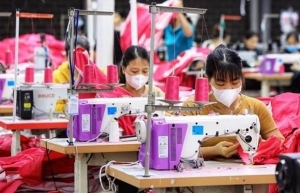New colours painted for Vietnam’s recovery
 |
| Ngo Dang Khoa, head of Markets & Securities HSBC Vietnam (left) and Vu Binh Minh associate director of Rates Trading HSBC Vietnam |
Essentially, global demand has remained subdue for almost the whole year. The global trade slowdown and China’s weak demand in particular have weighed on ASEAN’s growth prospects. Meanwhile, the US’ higher-for-longer policy rate environment has not helped to bring inflation down to its target, at least within this year.
As in many export-oriented economies, sluggish external demand remains the main challenge for Vietnam. Major shipments, including textiles/footwear and mobile phones, all suffered double-digit declines in the first few months of the year. That said, Vietnam’s trade sector has been improving. November saw export growth of 6.7 per cent year-on-year, marking the third consecutive month of export growth on a y-o-y basis.
While textiles and footwear exports remained sluggish, other shipments such as computer-related parts, machinery and agricultural products have displayed some impressive growth. That said, we remain cautious of the trade prospects, as demand for goods from major trading partners remains challenging.
Encouragingly, domestic activity continues to act as a firm pillar for this year’s economic growth. Indeed, the relaxation of visa policy since August has driven a sustained recovery in international tourists.
Meanwhile, despite the ongoing external drag, foreign direct investment has been pouring into ASEAN. Newly registered foreign investment into Vietnam’s manufacturing sector in 2023 was more than in each of the past three years. The country has turned itself into a rising star in the global manufacturing supply chain. While much of the investment initially entered the lower value-add textile and footwear space, Vietnam has quickly climbed up the value chain.
Last but not least, inflation has broadly remained in check. The average consumer price index (CPI) in Jan-Nov rose 3.22 per cent year-on-year, well below the 4.5 per cent ceiling set by the National Assembly.
Monetary market
In terms of foreign exchange, 2023 marked another volatile year for the USD/VND currency pair, although the amplitude is not as large as the second half of 2022. Overall, VND has depreciated by about 3 per cent year-to-date. The main drivers on exchange rate movement this year lie between interest rates and risks, inflation versus growth.
Weak growth, rapidly cooling inflation, and reduced concerns of outsized FX volatility have seen Vietnam’s policy priority centred around promoting growth. This remains in stark contrast to the US, where a hot labour market and sticky core inflation have led the Fed to adopt a restrictive monetary policy. The ongoing monetary policy divergence and the flush VND liquidity condition have driven a higher USD/VND for most of the year.
The continued hawkish stance of central banks have sparked concerns of potential spillover impacts on the economy – with the first of such worries crystallising in March, with a banking sector crisis. Additionally, growth momentum began to peter out, particularly in the Eurozone and the UK, and the mainland Chinese economy remained stuck with little forthcoming policy support. Amidst these uncertainties, the USD fluctuated within a broad range.
In terms of interest rates, given the intensifying challenges in the first few months of 2023, The State Bank of Vietnam (SBV) had stepped up its support effort by adopting a more accommodative monetary policy. In particular, the SBV was one of Asia’s first central bank to cut its key policy rates. In less than three months, it had delivered surprising cuts to its policy rate by three times, each time of 50bp.
Moderate inflation and stable VND liquidity were necessary factors for SBV to deliver rate cuts to support growth. Subsequently, the interest rate environment in general and lending rate levels in particular have been heading down lower in compared to the H2 of 2022, supporting businesses to have an easier access to funding, warming up the real estate market as well as the stock market in the last months of the year.
New hues for 2024
It appears the most difficult times are behind us. Contributing to economic recovery was improvement in trade that began in Q4/2023. November marked the third consecutive month of Vietnam seeing export growth on a year-on-year basis.
In particular, new areas with export growth potential, such as agricultural products, also continued to show signs of healthy growth that provided necessary support towards a better export result towards year-end. Besides that, domestic consumption has remained a firm pillar for the growth story.
That said, the recovery is uneven as shipments for some segments such as textiles and footwear remain sluggish. It may take some time to eventually see a broad recovery in trade. On the other hand, registered foreign capital remains very positive, reflecting Vietnam’s magnet as a rising manufacturing hub. Meanwhile, the government has approved a GDP growth target of 6-6.5 per cent for 2024, reflecting expectations of a continuous improvement in economic activity next year.
In general, the CPI is still well controlled. Despite some upside risks from potentially higher food and energy prices, core inflation are still lower than the average target of 4.5 per cent set out by the government.
In addition to maintaining flexible monetary policy along with keeping flush VND liquidity, the SBV is introducing various solutions to promote credit growth, which was only 9.87 per cent year-on-year as of December 13, much lower than this year’s target of 14 per cent. Given a stable global outlook and moderate inflation, the HSBC Global Research team expects the SBV to hold the interest rate steady over our forecast horizon.
For FX, the team expects some further upside for USD-VND in the next few months, mainly due to four drivers. Firstly, the monetary policy divergence between the Fed and the SBV will be likely ongoing in the near term. Secondly, the flush VND liquidity condition continues to be a sticky issue due to lower-than-expected credit growth and slow public investment disbursement.
Thirdly, while Vietnam’s trade surplus and foreign investment remain high, global volatilities will likely generate negative impact on global trade. Finally, USD is expected to remain stronger in the H1 of 24, coupled with a weakened CNY, which in turn will also directly impact on USD-VND volatilities and fluctuations.
 | Fitch Ratings forecasts Vietnam’s favourable medium-term growth Credit rating agency Fitch Ratings has forecast Vietnam’s growth in the medium term at around 7 per cent, with many favourable signs. |
 | Vietnamese economy expands 5.05 per cent in 2023: GSO Vietnam’s gross domestic product (GDP) growth rate is estimated at 5.05 per cent in 2023, the General Statistics Office (GSO) announced on December 29. |
What the stars mean:
★ Poor ★ ★ Promising ★★★ Good ★★★★ Very good ★★★★★ Exceptional
Related Contents
Latest News
More News
- Tax sector wraps up 2025 and sets priorities for next year (December 25, 2025 | 14:00)
- A tipping point for digital and hybrid wealth management in Vietnam (December 23, 2025 | 13:33)
- $250 million deal targets women-owned SMEs, sustainable agriculture (December 22, 2025 | 17:40)
- Stock market posts resilient 2025 performance (December 19, 2025 | 18:17)
- Citi Vietnam receives 2025 AmCham CSR recognition (December 19, 2025 | 16:35)
- As global green supply chain reshapes, will Vietnam be left behind? (December 19, 2025 | 08:00)
- Banks gear up for massive capital increases (December 18, 2025 | 17:04)
- Securing capital and efficiency for Vietnam’s 2026-2030 growth ambitions (December 17, 2025 | 10:00)
- Energy sector in need of blended finance mechanisms (December 17, 2025 | 09:00)
- Vietnam still has room to mobilise capital for sustainable growth (December 17, 2025 | 08:57)

 Tag:
Tag:





















 Mobile Version
Mobile Version